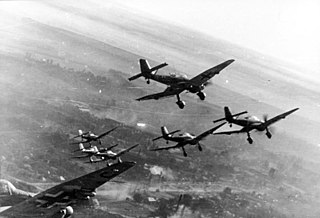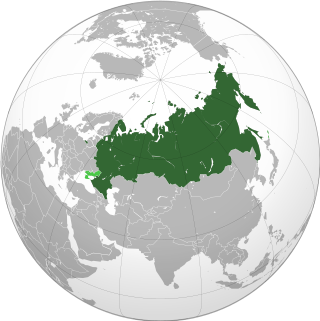
World War II or the Second World War was a global conflict between two coalitions: the Allies and the Axis powers. Nearly all the world's countries—including all the great powers—participated, with many investing all available economic, industrial, and scientific capabilities in pursuit of total war, blurring the distinction between military and civilian resources. Tanks and aircraft played major roles, with the latter enabling the strategic bombing of population centres and delivery of the only two nuclear weapons ever used in war. World War II was the deadliest conflict in history, resulting in 70 to 85 million deaths, more than half being civilians. Millions died in genocides, including the Holocaust of European Jews, as well as from massacres, starvation, and disease. Following the Allied powers' victory, Germany, Austria, Japan, and Korea were occupied, and war crimes tribunals were conducted against German and Japanese leaders.

Nuclear warfare, also known as atomic warfare, is a military conflict or prepared political strategy that deploys nuclear weaponry. Nuclear weapons are weapons of mass destruction; in contrast to conventional warfare, nuclear warfare can produce destruction in a much shorter time and can have a long-lasting radiological result. A major nuclear exchange would likely have long-term effects, primarily from the fallout released, and could also lead to secondary effects, such as "nuclear winter", nuclear famine, and societal collapse. A global thermonuclear war with Cold War-era stockpiles, or even with the current smaller stockpiles, may lead to various scenarios including human extinction.

Mutual assured destruction (MAD) is a doctrine of military strategy and national security policy which posits that a full-scale use of nuclear weapons by an attacker on a nuclear-armed defender with second-strike capabilities would result in the complete annihilation of both the attacker and the defender. It is based on the theory of rational deterrence, which holds that the threat of using strong weapons against the enemy prevents the enemy's use of those same weapons. The strategy is a form of Nash equilibrium in which, once armed, neither side has any incentive to initiate a conflict or to disarm.

World War III, also known as the Third World War, is a hypothetical future global conflict subsequent to World War I (1914–1918) and World War II (1939–1945). It is widely assumed that such a war would involve all of the great powers, like its predecessors, as well as the use of nuclear weapons or other weapons of mass destruction, surpassing all prior conflicts in geographic scope, devastation and loss of life.

The nuclear arms race was an arms race competition for supremacy in nuclear warfare between the United States, the Soviet Union, and their respective allies during the Cold War. During this same period, in addition to the American and Soviet nuclear stockpiles, other countries developed nuclear weapons, though no other country engaged in warhead production on nearly the same scale as the two superpowers.

The Russian Federation is known to possess or have possessed three types of weapons of mass destruction: nuclear weapons, biological weapons, and chemical weapons. It is one of the five nuclear-weapon states recognized under the Treaty on the Non-Proliferation of Nuclear Weapons and one of the four countries wielding a nuclear triad.

The Single Integrated Operational Plan (SIOP) was the United States' general plan for nuclear war from 1961 to 2003. The SIOP gave the President of the United States a range of targeting options, and described launch procedures and target sets against which nuclear weapons would be launched. The plan integrated the capabilities of the nuclear triad of strategic bombers, land-based intercontinental ballistic missiles (ICBM), and sea-based submarine-launched ballistic missiles (SLBM). The SIOP was a highly classified document, and was one of the most secret and sensitive issues in U.S. national security policy.

The military history of the Soviet Union began in the days following the 1917 October Revolution that brought the Bolsheviks to power. In 1918 the new government formed the Red Army, which then defeated its various internal enemies in the Russian Civil War of 1917–22. The years 1918–21 saw defeats for the Red Army in the Polish–Soviet War (1919–21) and in independence wars for Estonia (1918–20), Latvia (1918–20) and Lithuania (1918–19). The Red Army invaded Finland ; fought the Battles of Khalkhin Gol of May–September 1939 against Japan and its client state Manchukuo; it was deployed when the Soviet Union, in agreement with Nazi Germany, took part in the invasion of Poland in September 1939, and occupied the Baltic States, Bessarabia and Northern Bukovina. In World War II the Red Army became a major military force in the defeat of Nazi Germany and conquered Manchuria. After the war, it occupied East Germany and many nations in central and eastern Europe, which became satellite states in the Soviet bloc.
World War II officially ended in Asia on September 2, 1945, with the surrender of Japan on the USS Missouri. Before that, the United States dropped two atomic bombs on Japan, and the Soviet Union declared war on Japan, causing Emperor Hirohito to announce the acceptance of the Potsdam Declaration on August 15, 1945, which would eventually lead to the surrender ceremony on September 2.

This is a timeline of the main events of the Cold War, a state of political and military tension after World War II between powers in the Western Bloc and powers in the Eastern Bloc.

The militarisation of space involves the placement and development of weaponry and military technology in outer space. The early exploration of space in the mid-20th century had, in part, a military motivation, as the United States and the Soviet Union used it as an opportunity to demonstrate ballistic-missile technology and other technologies having the potential for military application. Outer space has since been used as an operating location for military spacecraft such as imaging and communications satellites, and some ballistic missiles pass through outer space during their flight. As of 2018, known deployments of weapons stationed in space include only the Almaz space-station armament and pistols such as the TP-82 Cosmonaut survival pistol.

The Third World War and The Third World War: The Untold Story are war novels by General Sir John Hackett, published in 1978 and 1982, by Macmillan in New York and Sidgwick & Jackson in London, respectively. The novels detail a hypothetical World War III waged between NATO and the Warsaw Pact in 1985, written in the style of a non-fiction historical retrospective interspersed with accounts of the conflict from the perspectives of various people.

World War III, sometimes abbreviated to WWIII, is a common theme in popular culture. Since the 1940s, countless books, films, and television programmes have used the theme of nuclear weapons and a third global war. The presence of the Soviet Union as an international rival armed with nuclear weapons created persistent fears in the United States and vice versa of a nuclear World War III, and popular culture at the time reflected those fears. The theme was also a way of exploring a range of issues beyond nuclear war in the arts. U.S. historian Spencer R. Weart called nuclear weapons a "symbol for the worst of modernity."
The aftermath of World War II saw the rise of two global superpowers, the United States (US) and the Soviet Union (USSR). The aftermath of World War II was also defined by the rising threat of nuclear warfare, the creation and implementation of the United Nations as an intergovernmental organization, and the decolonization of Asia, Oceania, South America and Africa by European and East Asian powers, most notably by the United Kingdom, France, and Japan.
The following outline is provided as an overview of and topical guide to World War II:
This timeline of nuclear weapons development is a chronological catalog of the evolution of nuclear weapons rooting from the development of the science surrounding nuclear fission and nuclear fusion. In addition to the scientific advancements, this timeline also includes several political events relating to the development of nuclear weapons. The availability of intelligence on recent advancements in nuclear weapons of several major countries is limited because of the classification of technical knowledge of nuclear weapons development.

Ukraine, formerly a republic of the Union of Soviet Socialist Republics (USSR) from 1922–1991, once hosted Soviet nuclear weapons and delivery systems on its territory. The former Soviet Union had its nuclear program expanded to only four of its republics: Belarus, Kazakhstan, Russia, and Ukraine. After its dissolution in 1991, Ukraine became the third largest nuclear power in the world and held about one third of the former Soviet nuclear weapons, delivery system, and significant knowledge of its design and production. Ukraine inherited about 130 UR-100N intercontinental ballistic missiles (ICBM) with six warheads each, 46 RT-23 Molodets ICBMs with ten warheads apiece, as well as 33 heavy bombers, totaling approximately 1,700 nuclear warheads that remained on Ukrainian territory.

The main issues of the United States foreign policy during the 1945–1953 presidency of Harry S. Truman include:

United States war plans for a conflict with the Soviet Union (USSR) were formulated and revised on a regular basis between 1945 and 1950. Although most were discarded as impractical, they nonetheless would have served as the basis for action had a conflict occurred. At no point was it considered likely that the Soviet Union or United States would resort to war, only that one could potentially occur as a result of a miscalculation. Planning was conducted by agencies of the Joint Chiefs of Staff, in collaboration with planners from the United Kingdom and Canada.














